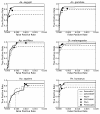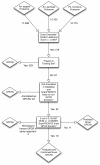Identification of novel arthropod vector G protein-coupled receptors
- PMID: 23705687
- PMCID: PMC3680159
- DOI: 10.1186/1756-3305-6-150
Identification of novel arthropod vector G protein-coupled receptors
Abstract
Background: The control of vector-borne diseases, such as malaria, dengue fever, and typhus fever is often achieved with the use of insecticides. Unfortunately, insecticide resistance is becoming common among different vector species. There are currently no chemical alternatives to these insecticides because new human-safe classes of molecules have yet to be brought to the vector-control market. The identification of novel targets offer opportunities for rational design of new chemistries to control vector populations. One target family, G protein-coupled receptors (GPCRs), has remained relatively under explored in terms of insecticide development.
Methods: A novel classifier, Ensemble*, for vector GPCRs was developed. Ensemble* was validated and compared to existing classifiers using a set of all known GPCRs from Aedes aegypti, Anopheles gambiae, Apis Mellifera, Drosophila melanogaster, Homo sapiens, and Pediculus humanus. Predictions for unidentified sequences from Ae. aegypti, An. gambiae, and Pe. humanus were validated. Quantitative RT-PCR expression analysis was performed on previously-known and newly discovered Ae. aegypti GPCR genes.
Results: We present a new analysis of GPCRs in the genomes of Ae, aegypti, a vector of dengue fever, An. gambiae, a primary vector of Plasmodium falciparum that causes malaria, and Pe. humanus, a vector of epidemic typhus fever, using a novel GPCR classifier, Ensemble*, designed for insect vector species. We identified 30 additional putative GPCRs, 19 of which we validated. Expression of the newly discovered Ae. aegypti GPCR genes was confirmed via quantitative RT-PCR.
Conclusion: A novel GPCR classifier for insect vectors, Ensemble*, was developed and GPCR predictions were validated. Ensemble* and the validation pipeline were applied to the genomes of three insect vectors (Ae. aegypti, An. gambiae, and Pe. humanus), resulting in the identification of 52 GPCRs not previously identified, of which 11 are predicted GPCRs, and 19 are predicted and confirmed GPCRs.
Figures





Similar articles
-
Decoding the ubiquitin-mediated pathway of arthropod disease vectors.PLoS One. 2013 Oct 21;8(10):e78077. doi: 10.1371/journal.pone.0078077. eCollection 2013. PLoS One. 2013. PMID: 24205097 Free PMC article.
-
VectorBase: a data resource for invertebrate vector genomics.Nucleic Acids Res. 2009 Jan;37(Database issue):D583-7. doi: 10.1093/nar/gkn857. Epub 2008 Nov 21. Nucleic Acids Res. 2009. PMID: 19028744 Free PMC article.
-
Genomic resources for invertebrate vectors of human pathogens, and the role of VectorBase.Infect Genet Evol. 2009 May;9(3):308-13. doi: 10.1016/j.meegid.2007.12.007. Epub 2008 Jan 3. Infect Genet Evol. 2009. PMID: 18262474 Free PMC article. Review.
-
Identification and comparative analysis of G protein-coupled receptors in Pediculus humanus humanus.Genomics. 2014 Jul;104(1):58-67. doi: 10.1016/j.ygeno.2014.06.002. Epub 2014 Jun 19. Genomics. 2014. PMID: 24952173
-
Insecticide resistance in Bemisia tabaci Gennadius (Homoptera: Aleyrodidae) and Anopheles gambiae Giles (Diptera: Culicidae) could compromise the sustainability of malaria vector control strategies in West Africa.Acta Trop. 2013 Oct;128(1):7-17. doi: 10.1016/j.actatropica.2013.06.004. Epub 2013 Jun 17. Acta Trop. 2013. PMID: 23792227 Review.
Cited by
-
Genomic analysis of two phlebotomine sand fly vectors of Leishmania from the New and Old World.PLoS Negl Trop Dis. 2023 Apr 12;17(4):e0010862. doi: 10.1371/journal.pntd.0010862. eCollection 2023 Apr. PLoS Negl Trop Dis. 2023. PMID: 37043542 Free PMC article.
-
The search for novel insecticide targets in the post-genomics era, with a specific focus on G-protein coupled receptors.Mem Inst Oswaldo Cruz. 2017 Jan 1;112(1):1-7. doi: 10.1590/0074-02760160345. Mem Inst Oswaldo Cruz. 2017. PMID: 28076467 Free PMC article. Review.
-
Genomic Signals of Adaptation towards Mutualism and Sociality in Two Ambrosia Beetle Complexes.Life (Basel). 2018 Dec 22;9(1):2. doi: 10.3390/life9010002. Life (Basel). 2018. PMID: 30583535 Free PMC article.
-
Combinatory annotation of cell membrane receptors and signalling pathways of Bombyx mori prothoracic glands.Sci Data. 2016 Aug 30;3:160073. doi: 10.1038/sdata.2016.73. Sci Data. 2016. PMID: 27576083 Free PMC article.
-
Characterization of an adulticidal and larvicidal interfering RNA pesticide that targets a conserved sequence in mosquito G protein-coupled dopamine 1 receptor genes.Insect Biochem Mol Biol. 2020 May;120:103359. doi: 10.1016/j.ibmb.2020.103359. Epub 2020 Mar 10. Insect Biochem Mol Biol. 2020. PMID: 32169582 Free PMC article.
References
-
- Pierce KL, Premont RT, Lefkowitz RJ. Seven transmembrane receptors. Nat Rev: Mol Cell Bio. 2002;3(9):639–650. doi: 10.1038/nrm908. http://www.ncbi.nlm.nih.gov/pubmed/12209124. - DOI - PubMed
-
- Broeck JV. Insect G protein-coupled receptors and signal transduction. Arch Insect Biochem Physiol. 2001;48:1–12. doi: 10.1002/arch.1054. http://www.ncbi.nlm.nih.gov/pubmed/11519072. - DOI - PubMed
-
- Wise A, Gearing K, Rees S. Target validation of G-protein coupled receptors. Drug Discov Today. 2002;7(4):235–246. doi: 10.1016/S1359-6446(01)02131-6. http://www.ncbi.nlm.nih.gov/pubmed/11839521. - DOI - PubMed
-
- Adams M, Celniker S, Holt R, Evans C. The genome sequence of Drosophila melanogaster. Science. 2000;287(5461):2185–2195. doi: 10.1126/science.287.5461.2185. http://www.sciencemag.org/cgi/doi/10.1126/science.287.5461.2185http://ww.... - DOI - DOI - PubMed
-
- Hill CA, Fox AN, Pitts RJ, Kent LB, Tan PL, Chrystal MA, Cravchik A, Collins FH, Robertson HM, Zwiebel LJ. G protein-coupled receptors in Anopheles gambiae. Science. 2002;298(5591):176–178. doi: 10.1126/science.1076196. http://www.ncbi.nlm.nih.gov/pubmed/12364795. - DOI - PubMed
Publication types
MeSH terms
Substances
Grants and funding
LinkOut - more resources
Full Text Sources
Other Literature Sources

